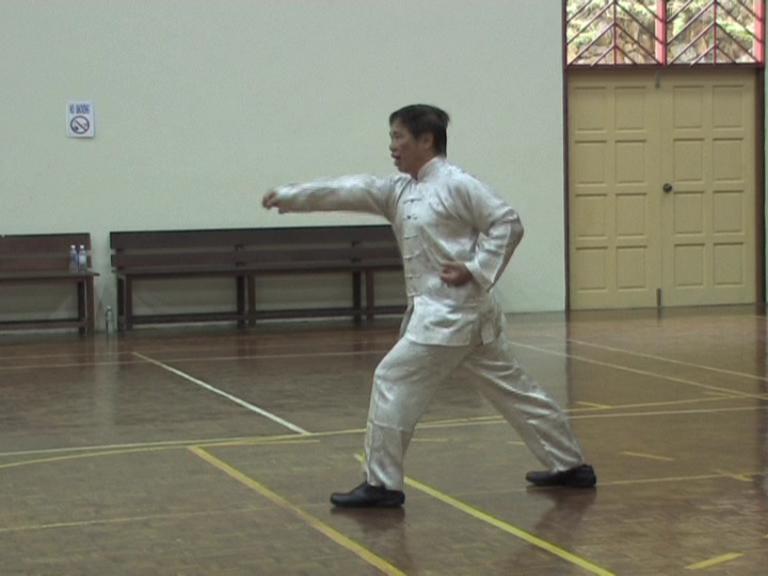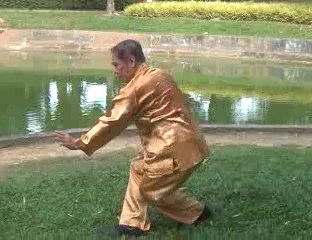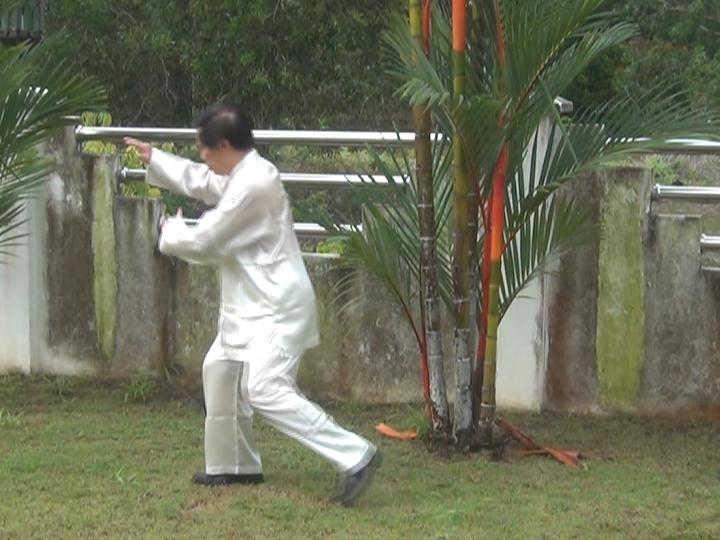SELECTION OF QUESTIONS AND ANSWERS
MARCH 2014 PART 1

Internal force spirals out from the dan tian
Question 1
I have been reviewing the video of the fundamental training program, especially the first few sections on footwork, hand techniques and the section on “Lohan Asks The Way”, in an effort to refine the quality of my movement and improve my flow.
— Sifu Gordon Pfeffer, Shaolin Wahnam Canada
Answer
Many people mention that the basics are important, which is very true, but they do not really know what the basics are. There are many stages of basics, depending on one’s developmental level.
For beginners, the basics are the stances and footwork, and fundamental hand techniques, i.e. the four hand strikes to the top, middle, bottom and sides, and their defence.
These basic hand patterns are linked together into a fundamental set, “Lohan Asks the Way”. This leads to the next stage of basics, the basics of set practice.
There are three levels in the basics of set practice, namely form, force and speed.
First we aim at picture-perfect form. Then we perform each form with appropriate force. This leads to fa-jing, or exploding force. In Shaolin training, “Black Tiger Steals Heart” is a good technique to develop the skill of fa-jing.
When we have sufficient skill in fa-jing using “Black Tiger Steals Heart”, we can progress to using fa-jing with the other three fundamental patterns, namely “Poisonous Snake Shoots Venom”, “Precious Duck Swims through Lotus” and “Hand a Golden Star”.
Then we go to fa-jing with the defence patterns, “Single Tiger Emerges from Cave”, “Golden Dragon Plays with Water”, “False Leg Hand Sweep”, and “Immortal Emerges from Cave”. The difference between hard force and soft force, flowing force and consolidated force is introduced. “Golden Dragon”, for example, is soft and flowing, whereas “Immortal” is hard and consolidated.
At the next level we learn various breathing methods for breath control. We link various patterns together and perform them in one breath, as if they were one long, continuous pattern. In this way we attain speed without sacrificing force and form. We systematically speed up the performance of “Lohan Asks the Way” from 36 seconds to just 4 seconds.
We then progress to combat application. The first four combat sequences, which compose “Black Tiger Steals Heart”, focuses on developing basic combat skills. The second set of four sequences, which compose “Happy Bird Hops up Branch”, focus on extending the range of techniques.
When we are skillful in the first 4 combat sequences and understand their underlying philosophy, we can handle any hand attacks! This is very cost-effective. Instead of learning each defence against countless hand attacks one at a time, we just learn the four basic attacks and defences, and by extension we can counter any hand attacks.
The next four combat sequences provide the philosophical framework to expand our basic hand attacks in countless ways. Various tactics, like defence-cum-attack, and no-defence-direct-counter, are also introduced.
Hand strikes are the basic of the four categories of attacks, namely striking, kicking, felling and chin-na. When we are skillful in hand strikes we just add the other modes of attack. We also use the instructional framework when learning the other attack modes.
Question 2
I rediscovered some really important things such as the importance of “spiraling'’ rather than just rotating from the waist. It totally changes the quality of the movement, seems to allow the body to naturally move or transition through the different stances when moving around and it seems to allow the hands to change positions in way that does not leave an opening to the opponent’s attack.
Answer
I am glad you not only grasp the essence of spiraling, in contrast to just rotating, but also experience its benefit.
Many people, including masters, talk about spiral force, known as “chan si jing” in Taijiquan and is badly translated as “cocoon force”, but from the ways they describe it, it is obvious they don’t know what it is. Even the more basic rotation of the waist is not understood, despite it being very important. Even Taiji masters shift their body forward instead of rotating their waist.

Rotating the waist is very important in Taijiquan
Question 3
Even though at first glance it may appear to a non-Shaolin practitioner we are leaving them an offering. I am also starting to see where there may be some trapping and chin na hidden in the movements of even the simple hand techniques.
However, right now I am focusing my efforts on refining the quality of my movement so that I can better understand my kung fu in general and to be able to teach it correctly.
Answer
Shaolin Kungfu has been so debased that not only non-Shaolin practitioners but even Shaolin practitioners at masters’ level miss its basic meaning, least of all its depth, and therefore not enjoy its wonderful benefits not just for combat but more significantly today for daily living.
It has become a norm that Shaolin practitioners today, including those at masters’ level, tense their muscles, grimace their face and use kick-boxing for sparring, and in daily life are angry and stressful instead of being peaceful and happy as genuine Shaolin training should bring.
Other people reading this may think us arrogant, but we are not afraid to state facts, not to belittle others or glamorize ourselves but as an attempt to restore the greatness of Shaolin Kungfu. Your training and understanding, and spreading the benefits to deserving students is a step in the right direction.
Question 4
I don't understand why our three golden rules don't apply to those who have a low income. Can you please explain?
— Edward, Singapore
Answer
Our three golden rules of practice apply to us, but may not apply to other chi kung practitioners in other schools. For our students the rules apply irrespective of their income level.
I use income as an analogy to illustrate the first golden rule of not worrying. I don’t mean the rule does not apply to our students who have low incomes.
Suppose a person earns only $2000 a month. If, due to his carelessness, he pays $1500 for housing instead of $1000, and $1000 for food instead of $800, he can't afford not to worry because his income would not be enough to cover his expenditure.
It is different for someone who earns $10,000. If he pays $1500 for housing instead of $1000, and $1000 for food instead of $600 due to some mistakes, he can afford not to worry because his high income can more than enough cover for the extra cost due to his mistakes.
It is the same with chi flow. If a person has only 2000 units of chi flow, he can't afford not to worry if he makes mistakes because his chi flow is not enough to cover for his mistakes.
It is different for another person who has 10,000 units of chi flow. He can afford not to worry even when he makes some mistakes because his powerful chi flow can more than enough cover the adverse effects resulting from his mistakes.

Heavenly Dragon Descends on Earth
Question 5
I am a Karate practitioner. In my Karate, the forms are actually very difficult to use. Many of my techniques are derived from forms but have been modified. because many moves in my forms are really very fancy looking and looks very good like dance forms but it's really, really difficult to use in fighting.
— Kshitij, India
Answer
Your questions are very interesting and will open up many vantage points for martial arts.
All the patterns in Karate can be used for fighting. If you do not know how to use any Karate pattern for fighting, it is just that, i.e. you do not know. It is not that the pattern cannot be used for fighting.
Compared to Shaolin Kungfu or Taijiquan, Karate is straight-forward. One can see the combat applications of Karate patterns easily, but it is difficult to see the combat applications of many Shaolin and Taijiquan patterns.
Many people think that these Shaolin and Taijiquan patterns are flowery. But actually these apparently flowery patterns are very combat effective. Let us look at two examples which I am sending as attachment in this e-mail to you.
The first pattern is called "Heavenly Dragon Descends on Earth", and is taken from Xingyiquan. (Please see the picture above.) The second pattern is called "Cloud Hands", and is taken from Yang Style Taijiquan. (Please see the picture below.)
Many people will find it hard to believe that these two seemingly flowery patterns can be used to counter any attack. I repeat -- any attack!
Can they be used against round-house kicks? Of course. Can they be used against Miay Thai knee jabs to the ribs? Sure. Can they be used to counter a wrestler charging in with a shoot? Certainly. Can they be used against an attacker attempting a throw or a lock? Yes, any throw and any lock! Can they be used against attacks commonly seen in Sanda? This is relatively simple.
These two examples are taken at random. There are many patterns like these in kungfu that look flowery but are very combat effective. You may like my webpages on Is Shaolin Kungfu too Flowery for Combat? and Are these Kungfu Patterns Realistic and Practical in Combat? If you love Taijiquan, you would like A Pattern for All Occasions.
But today most kungfu practitioners do not know how to use them for combat. They do not even know how to use basic kungfu patterns against straight-forward punches and kicks, least of all against sophisticated attacks like throws and locks. Even if they know in theory, they do not have the skills to apply them in practice. Hence, they just bounce about like kick-boxers. The situation of kungfu today is pathetic.
Question 6
So for better adjusting I had to change the moves from those forms which looked like dancing to be a little different. I changed stances and a lot of things. Now I am able to use some techniques for fighting after having modified, but I'm still studying further. Does that need to be done even in Shaolin or any other Chinese kungfu?
Answer
Many people try to simplify kungfu, but without realizing that they are debasing the art.
Indeed, about 40 or 50 years ago in the 1960s and 1970s, some kungfu masters tried to simplify kungfu into what they called kungfu-do, borrowing the term from Karate, and also emulating Karate techniques and free sparring. Actually they are not kungfu masters, but we call them masters out of respect. Had they mastered kungfu, they would not try to modify and simplify kungfu, debasing it.
The techniques are in an art not because some smart Alex invented them. In the case of kungfu, the techniques were evolved from actual fighting by countless people over many centuries. At first the techniques were straight-forward, like simple punches, kicks and blocks. Over time they became more and more sophisticated, until today they have become so sophisticated that most people do not recognize their combat application.

Cloud Hands
Question 7
There are certain videos of yours which I doubt so much. You perform cat stance and keep your hands wide open. The ribs are wide open and it will be easy for a Muay Thai fighter to kick there with force. How do you think that such a fighting stance can help me counter Muay Thai? I mean it does but I feel it doesn’t help every time, and if you can, then please help me more in this aspect.
Answer
I don't know which videos you referred to. But you can be sure of the following three facts:
- Kungfu places a lot of importance on safety first. This means kungfu practitioners (if they practice genuine kungfu) cover themselves well.
- If there is an exposure, it is likely to be a trap (unless the practitioner does not practice genuine kungfu).
- No matter how well you cover yourself, an attacker can still attack you.
There are countless counters I can use if a Muay Thai fighter kicks my ribs with force. I may, for example, use the two examples mentioned above, namely "Heavenly Dragon Descends on Earth" or "Cloud Hands".
It would be interesting to ask how would a fragile-looking lady counter a ferocious Muay Thai fighter. You can get a lot of answers from my webpage Shaolin Counters against Muay Thai Attacks.
Question 8
Is that technique focusing more on distance maintenance? Or is there any other stance based on traditional Shaolin which you can show where I can cover my ribs and make my legs strong enough to handle Muay Thai low kicks as well as techniques to counter their continuous boxing and punch them back or kick them back?
Answer
As I do not know which technique you referred to, I cannot give you a specific answer. But a general answer is that it does not matter what technique a Shaolin practitioner adopts, he can use it for distance maintenance or close combat. Kungfu is alive.
This applies to all styles of kungfu, not just Shaolin. Of course, the practitioner must be practicing genuine kungfu. Unfortunately today most practitioners only practice external kungfu forms, and bounce about when they have to spar.
Making your legs strong enough to handle Muay Thai low kicks or any attacks is third-class kungfu. In first-class kungfu you don't have to meet your opponent's strong legs.
Using techniques to counter a Boxer's continuous punches or a Kick-Boxer's continuous kicks is third-class kungfu. In first-class kungfu the Boxer or Kick-Boxer has no chance to throw his second punch or kick, or not even the first punch or kick.
You can see some first-class kungfu used by a fragile-looking lady against a ferocious Muay Thai fighter in the webpage mentioned above.
Editorial Note
: Kshitij 's questions will be continued at
March 2014 Part 2
issue of the Question-Answer Series.
LINKS
Selected Reading
- Intensive Courses and Special Courses
- Wing Choon Pattern Names
- Is White Crane Steps on Snow Related to the Art of Lightness?
- Felling Tree with Roots
- Texas on the Road
